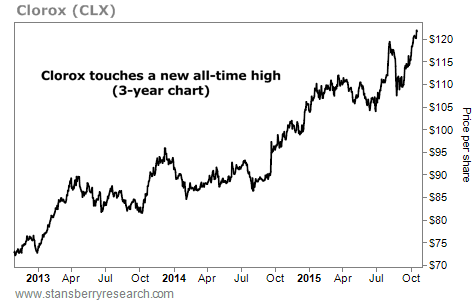| Home | About Us | Resources | Archive | Free Reports | Market Window |
|
Editor's note: Today, we're sharing a classic essay from our friend and colleague Mark Ford. We believe his ideas are so essential to wealth-building that all of our readers should be familiar with them. Below, we pass along one of the most insightful ideas on retirement we've ever read...
How the Big White Lie of Investing Could Cost You Your RetirementBy
Wednesday, October 21, 2015
I consider myself an expert of sorts on retirement. Not because I've studied the subject, but because I've retired three times.
Yes, I'm a three-time failure at retiring. But I've learned from my mistakes.
And I can tell you the biggest mistake retirees make is giving up all their active income...
By active income, I mean money you make through your labor or through a business you own. Passive income, on the other hand, is what you get from Social Security, a pension, or a retirement account.
It's a very common mistake. Yet I've never heard retirement experts mention it. Nor have I read a word about it in retirement books.
When you give up your active income, two bad things happen:
Here's how retirement is supposed to work: You save a portion of your income every month, let it grow in a tax-deferred investment vehicle, and accumulate a vault of wealth. Then, 40 years later, you tap into that vault to fund 20 years of easy living. No work. No stress. Nobody to kowtow to.
Just traveling, golfing, going to the movies, and visiting your kids and grandkids.
Yes, it's a great idea. But it was never realistic.
Prior to the 20th century, retirement was a rarity. Most people worked until they could no longer work, then "retired" into their children's homes.
The only generation that experienced "the dream" was my parents' generation – the men and women who bought starter homes and entered the workforce after World War II. They had good timing, because the U.S. was entering a 30-year growth spurt in business and real estate.
They made and saved money, but the bulk of their retirement funds came from selling their homes in 1980 for 10 times what they'd paid for them in 1950.
For every generation since then, the promise of that kind of retirement has been a big white lie.
Consider this: A "dream" retirement lifestyle for two would cost, on average, $75,000 per year (depending on where you live).
And that's after-tax dollars.
If you were in the 32% bracket, you'd have to earn about $110,000 to end up with $75,000. So, let's use this $110,000 figure.
How big of a retirement account do you need to produce $110,000 of cash flow each year?
Let's assume you and your spouse could count on $25,000 per year from Social Security and another $25,000 from a pension plan (two big assumptions). To earn the $60,000 balance in the safest way possible (from a savings account), you'd need about $6 million. (Savings accounts pay – at best – only 1% right now.)
If you were willing to take more risk and invest in tax-free municipal bonds, you'd need $2.1 million.
But let's say you were confident you could earn 8% from the stock market. You'd still need a nest egg of $750,000 to gross the extra $60,000 per year ($750,000 multiplied by 8%).
The problem: Most middle-class Americans are trying to retire with an account in the $250,000-$300,000 range.
And that's where the trouble begins. To achieve a return of $60,000 on $300,000, you'd need to earn 20% on your money. Getting (or attempting to get) 20% consistently over, say, 20 years is next to impossible – and too risky for my taste.
I retired for the first time when I was 39. I had a net worth of about $10 million, half of which was liquid. I thought I had all the money I'd ever need.
As it turned out, my retirement lifestyle was a lot more expensive than the $75,000 "dream" lifestyle I described earlier. I liked first-class travel, five-star hotels, and fancy cars. My yearly nut was close to $500,000.
To generate $500,000 in after-tax dollars, I would've had to earn $900,000 in passive-interest income on the $5 million I'd invested. That represents a return of 18%. I understood enough about stock market performance to know it was impossible.
I should've cut my expenses drastically. But I didn't want to. I enjoyed my lifestyle. So, I had no choice. I had to go back to work.
I put the word out and got a few offers. A month later, I was back at work. I half-expected to feel miserable toiling away.
But the moment I started earning money again, I felt better.
Retirement isn't supposed to be about money worries. Yet, if you retire with too little, that's exactly what you'll have. Trying to get above-market returns is challenging under any circumstance. But when you have to get high returns to pay the bills, it can be extremely stressful.
As I write this, millions of Americans my age are quitting their jobs and selling their businesses. They're reading financial magazines and subscribing to newsletters. They're hoping to find a stock-selection system that'll give them the 20%-40% returns they need.
But they'll find out such systems don't exist. They may have a few good years, but eventually, the returns they get will drop to 10% or less... if they're lucky.
And if there's another stock market crash, things will get bad – fast.
But it doesn't have to be this way.
Let's go back to the hypothetical situation I laid out earlier. You have a $300,000 retirement fund and a retirement dream that'll cost $75,000 in after-tax dollars.
To end up with $75,000 in after-tax dollars, you need an income of $110,000. You and your spouse have a total of $50,000 per year coming from Social Security and pension payments. But you still need $60,000 per year in pretax passive income.
To earn $60,000 on $300,000, you need a return of about 20%. That's highly improbable. But if you and your spouse both got part-time jobs that gave you an extra $15,000 per year in active income ($7,500 each), you'd need a return of only about 8% on your retirement account. And that's very doable.
I'm not saying you should give up on the idea of retirement. I'm saying you should think of retirement differently. Instead of spending 80% of your time working for money and 20% having fun, you can spend 20% of your time working and 80% having fun – and be free from financial worries.
That doesn't seem so bad, does it?
And if you're smart about the kind of work you do, you can actually have fun working!
There are many ways for a retired person to earn a part-time, active income. You could do some consulting, start your own online business, or earn money doing any sort of purposeful work.
Adjusting your understanding of "retirement" to include some active income isn't a huge burden. You can end up doing a lot of the same things you envisioned before – but get paid for it instead of doing it for free.
So please, move beyond the big white lie of investing. A rewarding and enjoyable retirement – devoid of money worries – awaits.
Regards,
Mark Ford
Further Reading:
Contrary to popular modern belief, Mark says, "The door to 'America's Millionaire Club' is not locked." If you have ambitions of being truly rich one day, read this classic essay.
Stansberry Research's free Education Center hosts some of the best tutorials on wealth-building we've ever published. If you're new to the markets, or would like to learn more about safe, successful investing, start here: 11 Steps to Maintaining and Building Wealth with Your Investments.
Market NotesTHIS 'BASICS' COMPANY CONTINUES TO OUTPERFORM Today's chart shows that one of the top "basics" companies continues to soar...
As we've mentioned many times over the years, owning companies that sell basic, everyday products is a winning investment strategy. These businesses have a history of beating the market and they often make for steady, reliable investments.
Today, we check in on consumer-products giant Clorox (CLX). Clorox doesn't just sell cleaning supplies... it also owns a wide array of brands you might find in your home right now. These include Brita water filters, Kingsford charcoal, Hidden Valley dressing, Glad trash bags, and even Burt's Bees skin care products.
As you can see from the chart below, Clorox shares have been steadily rising. They're up more than 60% over the past three years. And just yesterday, the stock struck a new all-time high. Clorox isn't a complicated, "exciting" business. It's a simple cash-flow machine that sells the basics...
 |
Recent Articles
|



